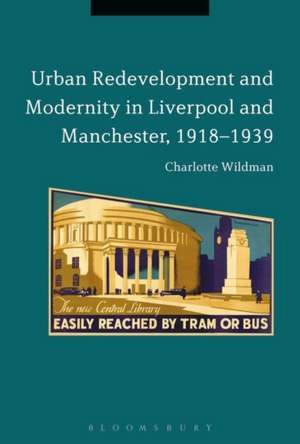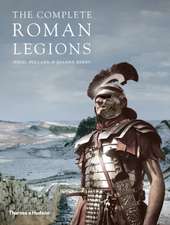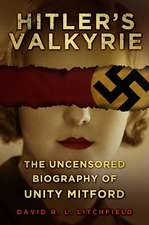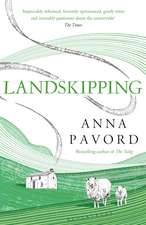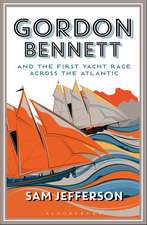Urban Redevelopment and Modernity in Liverpool and Manchester, 1918-1939
Autor Dr Charlotte Wildmanen Limba Engleză Paperback – 21 mar 2018
| Toate formatele și edițiile | Preț | Express |
|---|---|---|
| Paperback (1) | 239.02 lei 6-8 săpt. | |
| Bloomsbury Publishing – 21 mar 2018 | 239.02 lei 6-8 săpt. | |
| Hardback (1) | 775.02 lei 6-8 săpt. | |
| Bloomsbury Publishing – 21 sep 2016 | 775.02 lei 6-8 săpt. |
Preț: 239.02 lei
Preț vechi: 306.42 lei
-22% Nou
Puncte Express: 359
Preț estimativ în valută:
45.74€ • 47.75$ • 37.85£
45.74€ • 47.75$ • 37.85£
Carte tipărită la comandă
Livrare economică 05-19 aprilie
Preluare comenzi: 021 569.72.76
Specificații
ISBN-13: 9781350063839
ISBN-10: 1350063835
Pagini: 304
Ilustrații: 12 bw illus
Dimensiuni: 156 x 234 x 18 mm
Greutate: 0.43 kg
Ediția:NIPPOD
Editura: Bloomsbury Publishing
Colecția Bloomsbury Academic
Locul publicării:London, United Kingdom
ISBN-10: 1350063835
Pagini: 304
Ilustrații: 12 bw illus
Dimensiuni: 156 x 234 x 18 mm
Greutate: 0.43 kg
Ediția:NIPPOD
Editura: Bloomsbury Publishing
Colecția Bloomsbury Academic
Locul publicării:London, United Kingdom
Caracteristici
Provides a new and previously unknown account of the success of politicians and planners in Liverpool and Manchester in tackling severe economic and social instability through urban regeneration
Notă biografică
Charlotte Wildman is Lecturer in Modern British History, University of Manchester, UK.
Cuprins
1. Introduction: Urban Transformation in Liverpool and Manchester, 1918-19392. Chapter One: "Soaring Skyward": Urban Regeneration 3. Chapter Two: Civic Week Celebrations4. Chapter Three: "For Profit or Pleasure": New Cultures of Retail, Shopping and Consumer Culture5. Chapter Four: Performing Fashionable Selfhoods in the Transformed City6. Chapter Five: Gender, Religious Selfhoods and the City7. Chapter Six: The Cathedral That Never Was? 8. Conclusion: The Second World War and the Challenge to Interwar Urban CultureBibliographyIndex
Recenzii
This highly impressive monograph by Charlotte Wildman provides a fresh perspective by focusing on the often neglected interwar period in Liverpool and Manchester . [There] is no doubt that the study makes an outstanding contribution to the field of urban history, which students and academics will find invaluable for many years to come.
Charlotte Wildman is to be congratulated for taking on the complexity of the modern city and demonstrating so many intriguing ways forward in studying it.
This is a clear, convincing account of the interwar period which engages with a number of important discussions in twentieth-century British history. It should be read by all historians of twentieth-century Britain, particularly those working on the interwar period or with an interest in gender, religion, modernity, and political cultures.
Charlotte Wildman's excellent Urban Redevelopment and Modernity in Liverpool and Manchester, 1918-1939 challenges these images by placing the female shopper at the heart of the new city centres of the urban north.
[A] significant contribution to modern urban history, and to the study of gender, consumer culture, and religion. It is also a timely one: many of the themes that Wildman brings to the surface have more recently acquired a new significance.
[A] fine debut monograph ... It is in the conjunction of redevelopment and urban culture that the book's real strengths lie ... The study thus presents a convincing reassessment of inter-war cities that does much to add to our understandings of the development of urban cultures and identities with the framework of distinctly local modernities.
It is a compelling narrative, demonstrating the weaknesses of a long-held idea of municipal decline after the First World War as many of the functions of local government became increasingly 'nationalised' ... [It] makes an important intervention in a number of historiographical debates, reflecting its shifting focus on civic culture, consumption, gender and religion.
The major strength of the book lies in its assembling of diverse ranges of archival sources including film and images along with traditional documentary material. Consequently, a rounded view of the wider culture associated with civic pride and urban regeneration is provided in a compelling narrative.
Wildman should be praised for her careful revisionism and fresh approach to the interwar history of England's northern cities . The book contains useful figures and illustrations . Overall, then, this is a very useful monograph, well executed.
Charlotte Wildman is to be congratulated for taking on the complexity of the modern city and demonstrating so many intriguing ways forward in studying it.
This is a clear, convincing account of the interwar period which engages with a number of important discussions in twentieth-century British history. It should be read by all historians of twentieth-century Britain, particularly those working on the interwar period or with an interest in gender, religion, modernity, and political cultures.
Charlotte Wildman's excellent Urban Redevelopment and Modernity in Liverpool and Manchester, 1918-1939 challenges these images by placing the female shopper at the heart of the new city centres of the urban north.
[A] significant contribution to modern urban history, and to the study of gender, consumer culture, and religion. It is also a timely one: many of the themes that Wildman brings to the surface have more recently acquired a new significance.
[A] fine debut monograph ... It is in the conjunction of redevelopment and urban culture that the book's real strengths lie ... The study thus presents a convincing reassessment of inter-war cities that does much to add to our understandings of the development of urban cultures and identities with the framework of distinctly local modernities.
It is a compelling narrative, demonstrating the weaknesses of a long-held idea of municipal decline after the First World War as many of the functions of local government became increasingly 'nationalised' ... [It] makes an important intervention in a number of historiographical debates, reflecting its shifting focus on civic culture, consumption, gender and religion.
The major strength of the book lies in its assembling of diverse ranges of archival sources including film and images along with traditional documentary material. Consequently, a rounded view of the wider culture associated with civic pride and urban regeneration is provided in a compelling narrative.
Wildman should be praised for her careful revisionism and fresh approach to the interwar history of England's northern cities . The book contains useful figures and illustrations . Overall, then, this is a very useful monograph, well executed.
